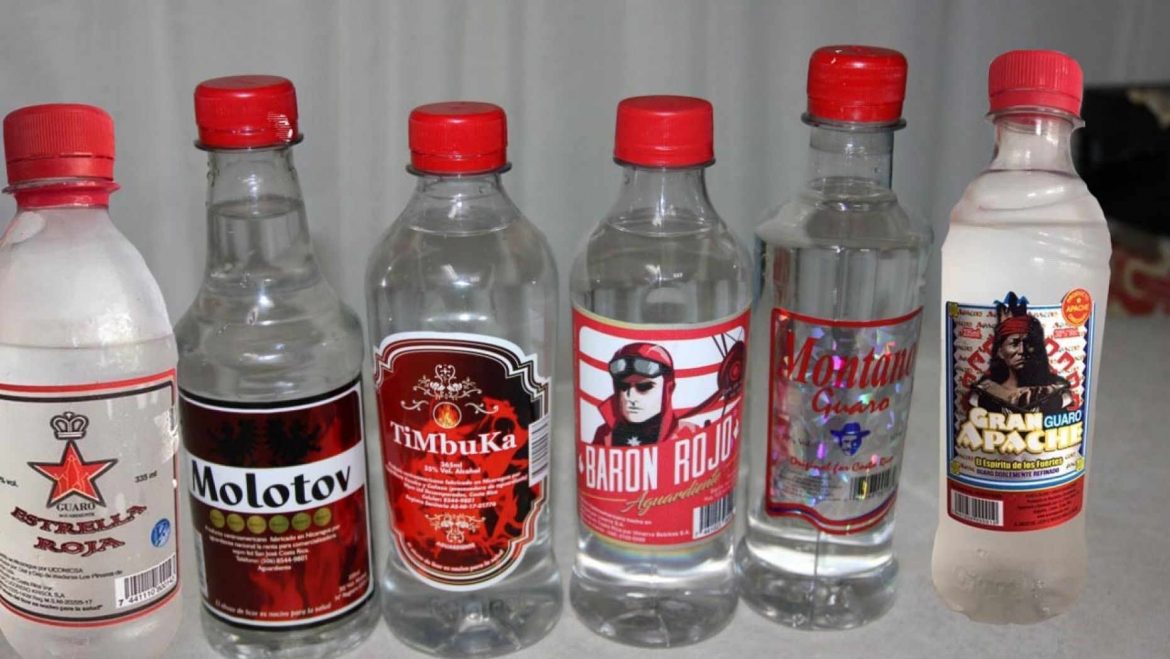First don’t drink cheap cheap alcohol in Costa Rica.
Costa Rica’s Ministry of Health has reports that 29 people have died there this year – up to September 5, see the bulletin (in Spanish) – due to methanol poisoning as a result of consuming tainted Guaro, a national drink distilled from sugar cane juices.
Twenty-two men and seven women died from lethal doses of methanol this year, aged between 32 and 87: ten in San José, two in Alajuela, four in Heredia, five in Cartago, three in Guanacaste, one in Puntarenas and four in Limón. An additional 76 cases are being investigated.
The good news is that the numbers are coming down. According to the Ministry of Health, only 15 new cases were reported in August, down from 50 the month earlier.
The Ministry of Health reports that, together with the Policía de Control Fiscal (tax police), Fuerza Publica (national police) and Municipal Police forces, have seized more than 66,000 containers of alcoholic beverages with health alerts issued in previous weeks.
In addition, more than a dozen liquor stores, mainly in San Jose and Alajuela, were shut down, as “operations” continue throughout the country in order to reduce the exposure of consumers to adulterated products, as well as investigations, in coordination with other institutions, to determine the adulteration.
In the Dominican Republic, at least 10 American tourists died mysteriously earlier this year. Following the deaths, the Federal Bureau of Investigation (FBI) launched an investigation to see if fake alcohol may have been involved. The FBI has taken alcohol samples from hotels where the deaths occurred and the toxicology reports have not yet been released.
The question, is Costa Rica a safe destination? Although the problem of tainted alcohol seems to be under control, a batch could surface at any time and at any place.
The Instituto Costarricense de Turismo (ICT) – Costa Rica Tourist Board – reaffirms that no tourists have been affected by adulterated alcohol in Costa Rica and that visitor safety is a priority.
Guaro is typically a local drink, an acquired taste if you will, a drink not common, though accessible, to tourists.
Guaro in Costa Rica is cheap. A 365ml bottle of Guaro Cacique is ¢1,750 colones, less than double the price of a can of soda or flavored water; a one-liter bottle ¢4,555 colones, delivered. The foregoing are prices for the real stuff, the bootlegged can go for a fraction.
Guaro made in Costa Rica can differ in taste from Guaro made in Colombia, Panama, Ecuador, El Salvador, Guatemala, Honduras, and Nicaragua. Colombians call it aguardiente.
Tainted alcohol poisoning incidents tend to occur in countries where the taxes on legitimate alcohol or the cost itself may be seen as too high, Larry Navin, director of government and public affairs at the Methanol Institute, told USA TODAY. Though tourists may be alarmed, there are ways to protect yourself and still enjoy a getaway.
What is methanol?
Methanol is alcohol, but it’s not the one used in adult beverages. Instead, methanol is in solvents, antifreeze and in fuel. It’s not safe for human consumption. There are a couple of ways methanol can wind up in your drink. One is when enterprises or people add industrial methanol to legitimate beverages, like a bottle of liquor, make it cheaper.
Improper brewing, which means the chemical doesn’t always end up there purposefully, can also result in tainted alcohol.
Protecting yourself
According to the Methanol Institute, it is possible to test for methanol with test strips that can detect methanol in drinks. However, the strips are difficult to create since there is a close relationship and similarity between the chemicals methanol and ethanol, plus they are expensive, and they aren’t widely used by the public yet.
When you arrive, steps to avoid consuming contaminated alcohol, include:
- Don’t consume homemade or local alcohol and mixed drinks.
- Stick to to beer and wine, mass-produced, well-known brands of alcohol.
- Buy hard alcohol at duty-free locations when you arrive at the airport.
- Avoid consuming drinks that are priced at a bargain.
Methanol poisoning
Symptoms for methanol poisoning include dizziness, weakness, headaches, nausea, vomiting, unconsciousness, blurred vision and blindness. Methanol poisoning can be treated if diagnosed within 10 to 30 hours of ingestion, says the Methanol Institute.
If a person is treated quickly, outcomes are usually good. But if left untreated, the ingestion of about 1 fluid ounce could be fatal.
Anyone with symptoms should seek immediate medical treatment.
From qCostaRica

